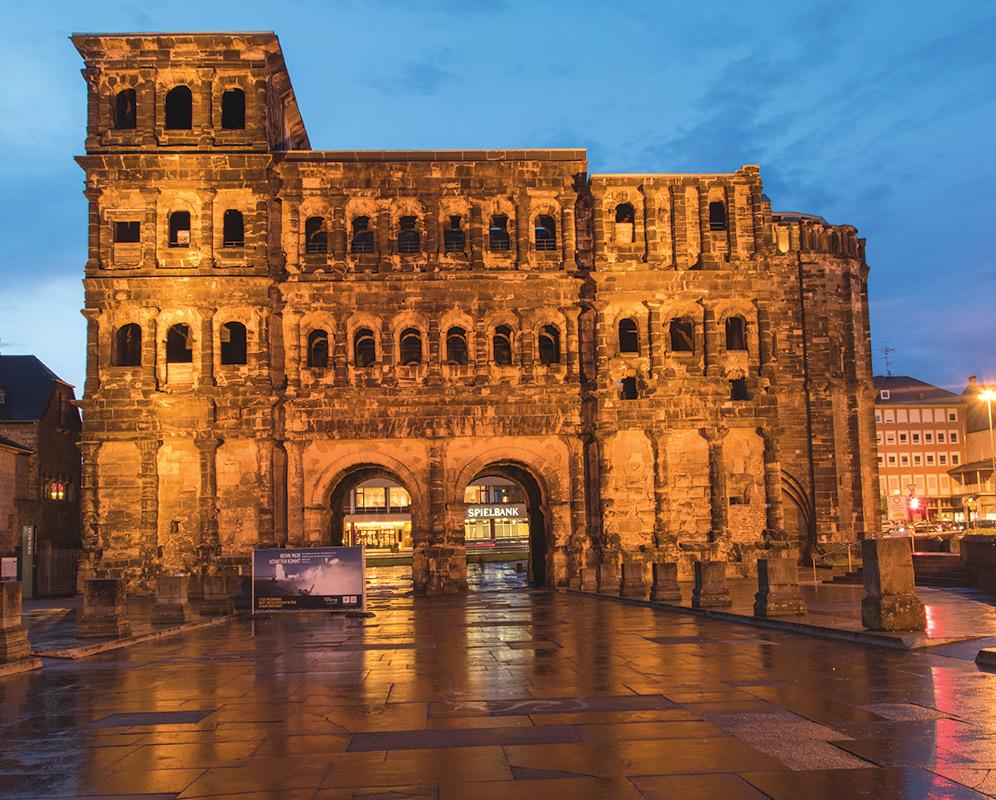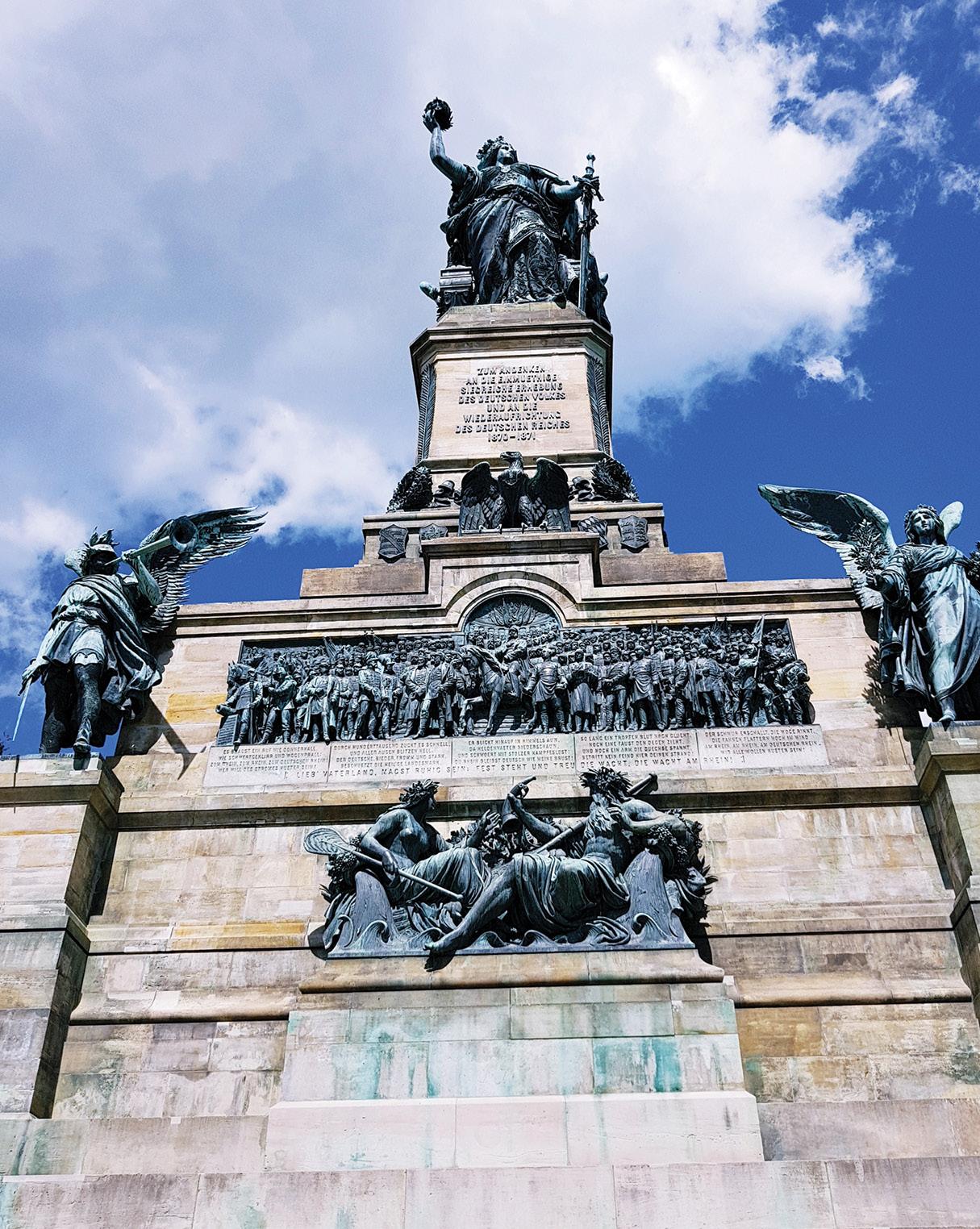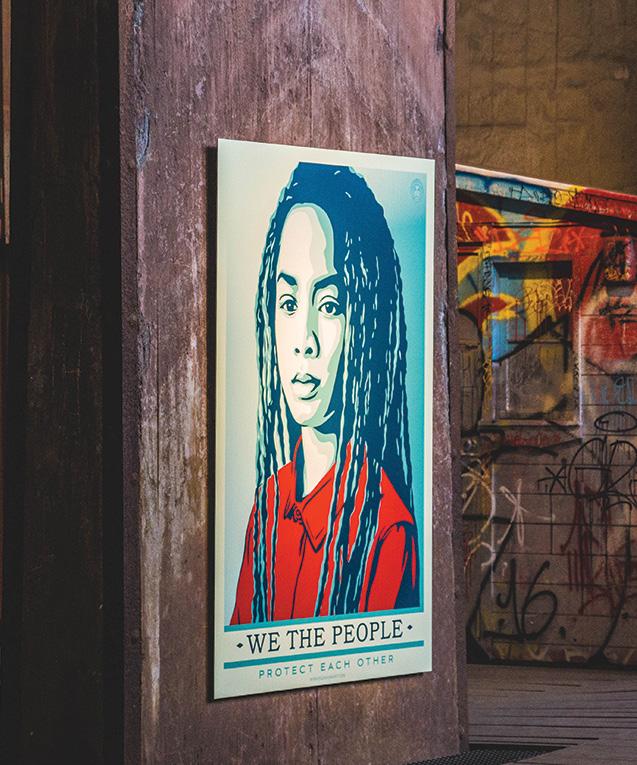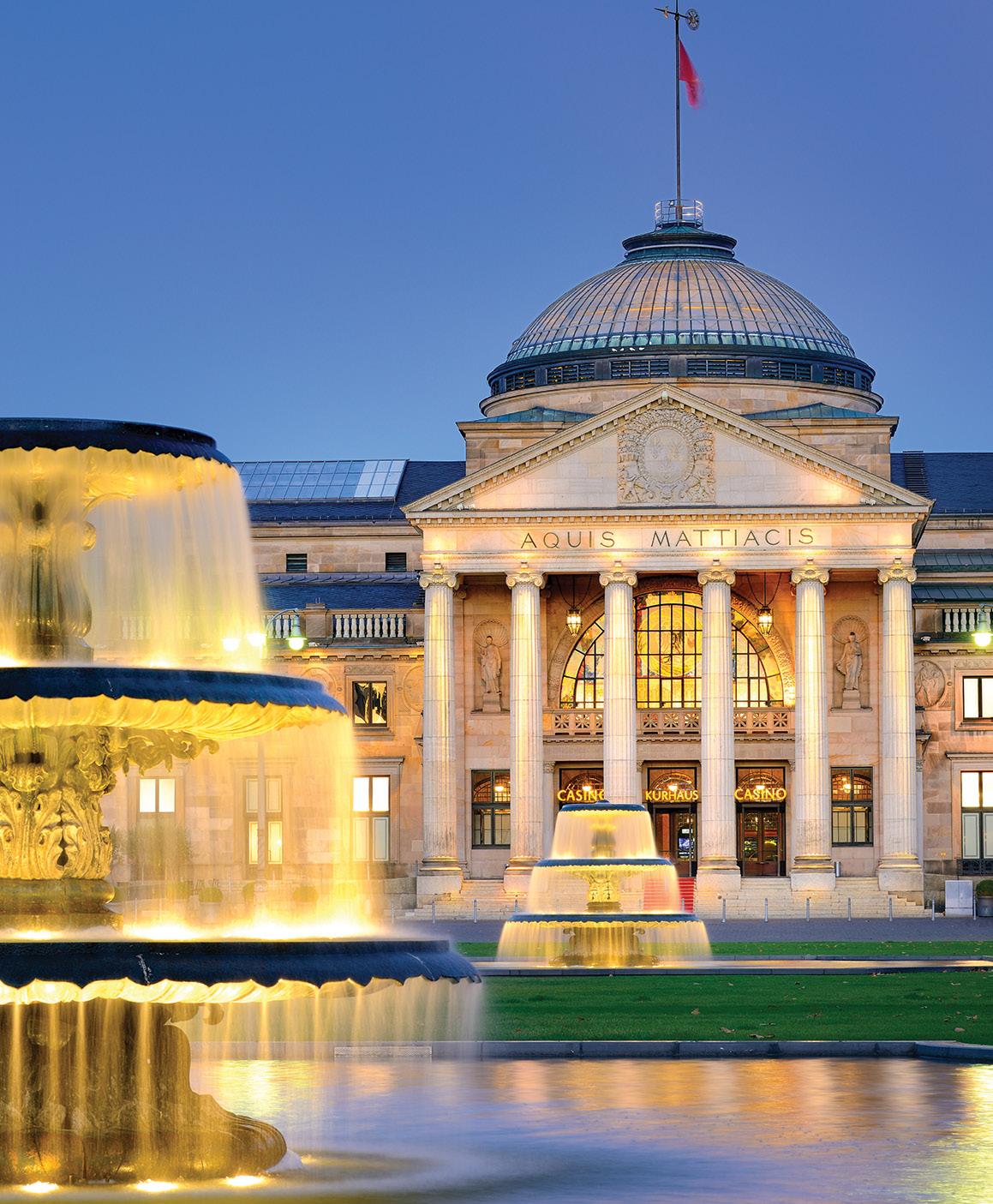
14 minute read
Destinations: Southwest Germany
The Quintessentially Charming Region of Southwest Germany
Text by SHAHIDA SAKERI Images by GERMAN NATIONAL TOURIST BOARD (GNTB), UNSPLASH AND PIXABAY
Germany is the world’s economic and innovations powerhouse, and its rich culture and heritage should also be given the same regard. As travellers venture to the country’s southwest region, they will be treated to riveting history that goes far back to the time of the Roman Empire, gorgeous landscapes of greeneries, enduring traditions, and outstanding architectural styles across multiple art periods. And then, there is also endless list of well-preserved UNESCO World Heritage sites, all possess their own stories. This region is perfect for travellers to get cultured and be inspired.

Postcard-perfect view of Benedictine Abbey of St. Hildegard.
Image by: GNTB
TRIER
1. Porta Nigra

A lasting Roman legacy, Porta Nigra.
Image by: Cornelia Schneider-Frank from Pixabay
If walls could talk, imagine the stories that the walls of this piece of historic legacy would divulge. Built in 170 A.D. during the Roman Empire – or 1,849 years ago – Porta Nigra is the only surviving gate out of the quartet of gates that used to guard Trier city. Its original Roman name remained unknown up until today, but as the facade began turning dark in the Middle Ages due to age, locals started calling it Porta Nigra (‘Black Gate’), which comprises two towers with a small courtyard in between, all built in typically Roman mortar-less technique (the structure’s large stones are held together by iron rods).
In 1030, a hermit named Simeon moved into the tower of Porta Nigra with the approval from the archbishop of Trier. When he died five years later, he was sanctified and his body was buried inside the gate. Porta Nigra soon transformed into a church, and because of its religious significance, the gate had been safe from the ever-changing marauders that came after. However, when Napoleon arrived in the city, he asked for the church to be dissolved and ordered it to be restored to its original role for defence. Today, visitors are welcome to explore the towers on their own at a small fee; but for more in-depth experience, opt for a tour complete with a guide dressed as a centurion.
2. Aula Palatina (Basilica of Constantine)
Built in 310 A.D., the throne room that once belonged to Emperor Constantine is today the largest surviving ancient Roman single-room structure. Its huge size often fascinates visitors, but one could only imagine the grandeur that the hall once commanded before it was remodelled and repurposed throughout the span of its history. In the Middle Ages, the hall had been converted into a fortress, living quarters for the city’s archbishops, and finally the first Protestant church for the city in 1856.
An air raid during World War II almost destroyed the building, but a thorough repair work managed to preserve the historical inner decorations from 19 th century.
3. Amphitheatre
Almost similar to the huge stadiums found today, amphitheatres were crucial in ancient Roman culture since they were built in major cities (often where emperors resided) to bring large-scale entertainment like gladiator fights to the people. The one in Trier could seat up to 20,000 spectators, connoting the city’s magnitude at that time.
4. Barbara Baths
In the past, baths were a community centre where Romans bathed together and socialised. Some of them were so big that they could incorporate multiple hot and cold baths, library, gymnasium and garden. One such infrastructure was the Barbara Baths, the oldest public bathing facility in the city. At the time of its construction, it was presumed to be almost the size of six American football pitches, making it the second largest of its kind in the whole of Roman Empire! Today, visitors can only witness the ruins, but there’s a visitor’s walkway built across the area for those who are interested to learn more about this splendid architecture and the conservation efforts initiated by the city council.
5. Imperial Baths
Another great example of Roman bathing facility in Trier is the Imperial Baths, relatively the newest in the city, considered as one of the most impressive complexes ever built in terms of grandeur. It comprises two areas: the thermae (baths) that was large enough to fit a present-day 650-seater opera, and the palaestra, which was a courtyard used for exercise. The complex was eventually converted into a castle during the Middle Ages.
6. Church of Our Lady
Originally, there was a Roman double church stood on site, until its southern section was torn down around 1200 and replaced by the Early Gothic Church of Our Lady, making it the first and oldest gothic church in the country.
7. Saint Peter’s Cathedral

Baroque west choir ceiling at Saint Peter’s Cathedral, Trier.
Image by: Erich Westendarp from Pixabay
This Roman Catholic church, also known as Trierer Dom, is the oldest bishop’s church in Germany, commissioned by the first Christian Roman emperor, Constantine the Great, in the fourth century. The church continued to flourish and stood the test of time, rebuilt and renovated along the way according to multiple period influences such as Gothic, Baroque and Renaissance. Yet, the Roman central section with the original walls remains intact and can still be seen today as part of this architectural masterpiece. The church also contains impressive Christian art and holy relics like the Seamless Robe of Jesus, though it is kept in an annex and rarely shown to the public.
8. Roman Bridge
Being the oldest bridge in the country that can still withstand heavy use up until today, Trier’s Roman Bridge is a fine example of the Roman’s architectural prowess. It was built in the second century, connecting the west bank to the city across Mosel River. While the foundation remains strong till today, the upper part had to be renewed twice over time due to destruction from wars.
9. Igel Column
At 23 metres tall, Igel Column is the tallest Roman burial tomb in the north of the Alps, built in 250 A.D. It pays tribute to the rich cloth merchant family called Secundinier, whose trading business believed to reach as far as Rome. Watch closely, and visitors would be able to admire the original ancient images on the column that show a glimpse of everyday scenes of trading life from about 1,800 years ago.
RÜDESHEIM AM RHEIN

The cable car ride over the picturesque Rhine Valley.
Image by: GNTB
This storybook town will leave a mark in one’s heart as a romantic destination, filled to the brim with pretty timbered houses and a string of medieval castles, draped in gorgeous vineyards that also known to produce worldfamous Riesling wines. The town is also a part of UNESCO World Heritage Upper Middle Rhine Valley.
1. Niederwald Monument

The 38-metre tall Niederwald Monument.
In the late 1860s, France was regarded as the most powerful country in mainland Europe, but its dominance was challenged by the rise of Prussia (historically prominent German state) that defeated Austria in the Seven Weeks’ War in 1866. The news of potential alliance between Prussia and Spain provoked France and led to the now famous Franco-Prussian War from 1870 to 1871. Prussia won, and subsequently resulted to the unification of various German states that formed the German Empire. A monument in Niederwald was created between 1870 and 1880 to commemorate this historic unification.
This 38-metre tall monument now towers above the Rhine Valley, treating its visitors not only lessons in history but also a fantastic panorama over the shimmering Rhine River, quaint villages and romantic vineyards. In fact, the best seat in the house to enjoy Rudesheim’s bewitching beauty is by taking a short cable car ride from the village to Niederwald Monument. Alternatively, visitors may also take the chairlift from nearby Assmannshausen village to the top of the hill.

The wall sculpture at the spa assembly room.
Image by: GNTB.
2. Benedictine Abbey of St. Hildegard (www.abtei-st-hildegard.de/english/)
Built in the 20 th century on top of the hill graciously overlooking the magnificent Middle Rhine Valley, the abbey evokes drama in the landscape with its Romanesque structure rising between the greenery of the surrounding vineyards. Inside, it displays beautiful frescoes, and sometimes used for concerts such as the Rheingau Musik Festival.
3. Drosselgasse
Step back in time in a charming cobblestoned alleyway that runs through the heart of the old town, where its origin dated back to the 15 th century. The street today spills out quaint artisanal shops and garden taverns, echoing conversations and music that blend well with the magical chimes from the nearby bell tower. For a true German hospitality, make way to Breuer’s Rüdesheimer Schlosss (www. ruedesheimer-schloss.com/en/), a familyrun restaurant that serves delicious regional cuisine for over 60 years, often accompanied by outstanding live band that plays both folk and contemporary music.
4. Rheinstein Castle
Fulfil your fairytale fantasy with a visit to an actual castle, Rheinstein, which depicts the Romanticism period at its best. Built in the late 13 th century, this castle was originally a customs castle meant to protect the Mainz territory against robber knights, but later got heavily destroyed due to wars around the 17 th century. In 1823, Prince Friedrich Wilhelm of Prussia acquired the ruins and revived it according to Romanticism style by adding a beautiful courtyard and Gothic altarpiece in the castle’s chapel. Travellers are allowed to roam within the towers, where they get to admire gorgeous stained-glass windows and three-dimensional paintings.
SAARBRÜCKEN
Saarbrücken is the capital of Saarland, which is one of the smallest states in Germany. But despite its modest size, the city prospers as an economic heart where a majority of people from the state work, making it one of the most densely populated areas in the country. Its laidback lifestyle attracts locals, whilst the gorgeous Baroque architectures and vibrant cultural scene draw travellers. Interestingly, the city also has a strong French influence since it borders with France, so don’t be surprised if you hear French being widely spoken here!
1. Völklingen Ironworks (www.voelklinger-huette.org/en/ welcome/)

‘We the People’ artwork as displayed in Völklingen Ironworks.
Image by: Adrienguh on Unsplash
Being a largely industrial city since the 18 th century, Saarbrücken celebrates many engineering milestones in its history, including the Völklingen Ironworks, which is the world’s only surviving smelting works from the late 19 th century. Up until today, the plant is considered as what UNESCO says “a symbol of human achievement during the First and Second Industrial Revolutions. At the height of its operation, Völklingen Ironworks employed 17,000 people.” Its finest technological innovations had benefitted the smelting industry at large, therefore when its production ceased in 1986, numerous efforts were taken to make sure that the plant doesn’t disappear in vain. In 1994, the plant became the first industrial site to be added to the World Heritage List.
Today, this somewhat surreal complex remains the same at most parts, and now opens as a museum where visitors can learn about the history of ironmaking. Information are presented in great detail, and travellers can even explore the production area. Guided tour is also available; however, advance booking is required. There is a 30-metre charging platform on site, now becomes a viewing platform that affords a spectacular view of the complex. From time to time, the complex plays a host to concerts and multiple art exhibitions, including the popular UrbanArt Biennale® that showcases incredible works from urban artists like Banksy, Shepard Fairey and Futura.
WIESBADEN
Wiesbaden is distinctively German, identified by its modernity and functionality. But upon closer look, it actually bursts with art, history, architecture and nature – a perfect combination that provides travellers a well-rounded experience. It is also known as one of the oldest spa towns in Europe, boasting a total of 26 hot springs, including the famous Kochbrunnen that can be found right in the city centre.
1. Kurhaus (www.wiesbaden.de/microsite/kurhausen/)

The dreamlike facade of Kurhaus.
Image by: GNTB
Following its popularity as a spa destination that peaked in the 19 th century, Wiesbaden attracted many upper-class visitors to the area, which eventually called for a larger and grander spa house to be built. The city’s original spa house was then demolished and replaced with a majestic neoclassical complex with two concert halls and a wine hall. A magnificent casino was later included in the building in 1949. During the 1980s, the structure was given an extensive renovation to equip it with modern technology upgrades to transform it into a world-class conference venue as it is today.
2. Hessian State Theatre (english.staatstheater-wiesbaden.de/)

The gorgeous Rococo-styled foyer at Hessian State Theatre.
The Hessian State Theatre on its own is a work of art, designed to personify the imposing and majestic Baroque Revival style in all its glory as visualised by two great Viennese architects, Ferdinand Fellner and Hermann Helmer. Eight years after its inauguration, as if the building wasn’t extravagant enough, an incredibly gorgeous Rococo styled foyer complete with cotton candy colours, gilded decorations and inset paintings was later added into the building, which until today, never fails to sweep you off
your feet. Today, Hessian State Theatre has the busiest calendar in the country’s performing arts industry, offering more than 900 performances each season. It also hosts the annual May Theatre Festival, one of Germany’s oldest festivals since 1896.
3. Museum Wiesbaden ( www.museum-wiesbaden.de/en )
The museum comprises two sections: art and natural history – the former showcases expressionism artworks of the 19 th and 20 th centuries, while the latter presents informative displays on zoological specimens and fossils, along with interactive zones that are especially fun for young zoologists. Since June 2019, the museum opens its permanent display of Art Nouveau collection by Ferdinand Wolfgang Neess, featuring 570 objects ranging from ceramics, furniture, and paintings to artworks, including Alphonse Mucha’s incredibly gorgeous bronze sculpture, La Nature.
4. Neroberg
Neroberg refers to the 800-foot high hill that offer spectacular views of the city as far as the slopes of Odenwald. One may take the Nerobergbahn (Neroberg Mountain Train) to reach the top in less than four minutes, while those who are fit should opt for a 15-minute pleasant hike to the summit. The hill is the spot where travellers can find a beautiful Russian Orthodox Church of Saint Elizabeth, built by the grief-stricken Duke Adolf of Nassau in loving memory of his wife, Elizabeth Mikhailovna, who died during childbirth only after a year of marriage.
The writer’s experience in Germany was truly amazing and insightful. Gaya Travel Magazine therefore extends its heartfelt gratitude to the German National Tourist Board for the wonderful trip and ensuring that the writer’s journey to Southwest Germany was smooth-sailing.
Travel Pointers when Exploring Germany
• Cash is essential because most local vendors would not accept credit cards. The best and easiest way to get cash is by withdrawing it at the ATM, preferably the bank-run ATMs as they usually do not charge usage fees and are generally more secure.
• Speaking of cash, do carry loose change at all times because free public restrooms are rare. They usually cost 50 cents per entry.
• Sunday, in Germany, is the day of rest, so expect to see almost all shops, including grocery stores, closed. Exceptions might apply to bakeries and restaurants.
• When dining in restaurants, the fizzy, sparkling water is served by default whenever you request for a glass of water. If you prefer still water, be sure to clarify when ordering.
• Germany, probably, has the most impressive transportation system in the world. Taking the low-cost airlines (Germanwings, Condor, etc) across the country saves time, but if you are not in a rush, taking busses (Flixbus, etc.) or trains are better since they take and drop passengers right in the city centre. And try to book well in advance when possible because it can save you a lot of money too. Alternatively, make use of the regional day tickets available by the national railway, the Deutsche Bahn (www.bahn.com/en/view/index. shtml), for bigger savings when travelling between cities.
• The country may not be the cheapest country to visit in Europe, but budget travel is still possible! Do budget at least MYR350 to MYR500 per day, taking into account staying at hostels and cooking your own meals to control cost.










